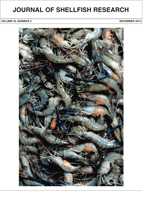A series of acute and sublethal experiments were conducted to examine the potential effects of exposure to wateraccommodated fractions (WAFs) of Macondo Canyon 252 crude oil and chemically enhanced (Corexit 9500A dispersant) wateraccommodated fractions (CEWAFs) on embryogenesis, larval development, growth, and survival of the eastern oyster, Crassostrea virginica. Nominal exposure concentrations for acute experiments were 0, 100, 200, 400, 800 and 1,200 mg/L for WAFs, and 0, 6.25, 12.5, 25, 50, 100, and 200 mg/L for CEWAFs. Calculated total polycyclic aromatic hydrocarbon (TPAH) values were 0, 22.5, 45, 90, 181, and 271 µg/L for WAFs, and 0, 4.5, 8.9, 17.8, 35.7, 71, and 142 µg/L for CEWAFs. The exposure concentration for sublethal experiments was 16 mg/L CEWAF. Total polycyclic aromatic hydrocarbon concentrations represent moderate to high levels of TPAH reported during the Deepwater Horizon (DWH) event. Exposure to acute concentrations of 1 or both of these contaminants was shown to decrease fertilization success (≥100 mg/L CEWAF), hinder trochophore (≥100 mg/L WAF, ≥12.5 mg/L CEWAF) and D-stage (≥200 mg/L WAF, ≥25 mg/L CEWAF) development, increase the risk of D-stage developmental abnormalities (≥100 mg/L WAF, ≥100 mg/L CEWAF), and decrease survival of D-stage (1,092 to 261.8 mg/L WAF, 24–96 h LC50; 177.6 to 24.8 mg/L CEWAF, 24–96 h LC50) and eyed (81.9 to 14.5 mg/L CEWAF; 24–96 h LC50) larvae. Exposure to CEWAFs, in general, resulted in increased toxicity over WAFs, likely as a result of the increased bioavailability of hydrocarbons. In contrast to acute exposures, short-term (24-h) sublethal exposure of D-stage larvae to CEWAFs (16 mg/L) had no impact on survival or growth. Although concentrations used represent possible TPAH exposure levels based on maximum reported values, these findings do not imply that oyster larvae were exposed to similar concentrations during or after the DWH event.
How to translate text using browser tools
1 November 2014
Effects of Macondo Canyon 252 Oil (Naturally and Chemically Dispersed) on Larval Crassostrea virginica (Gmelin, 1791)
Susan Laramore,
William Krebs,
Amber Garr
ACCESS THE FULL ARTICLE

Journal of Shellfish Research
Vol. 33 • No. 3
November 2014
Vol. 33 • No. 3
November 2014
chemically enhanced water-accommodated fraction
Corexit EC9500A
Crassostrea virginica
Deepwater Horizon
MC252
Oil spills
water-accommodated fraction




